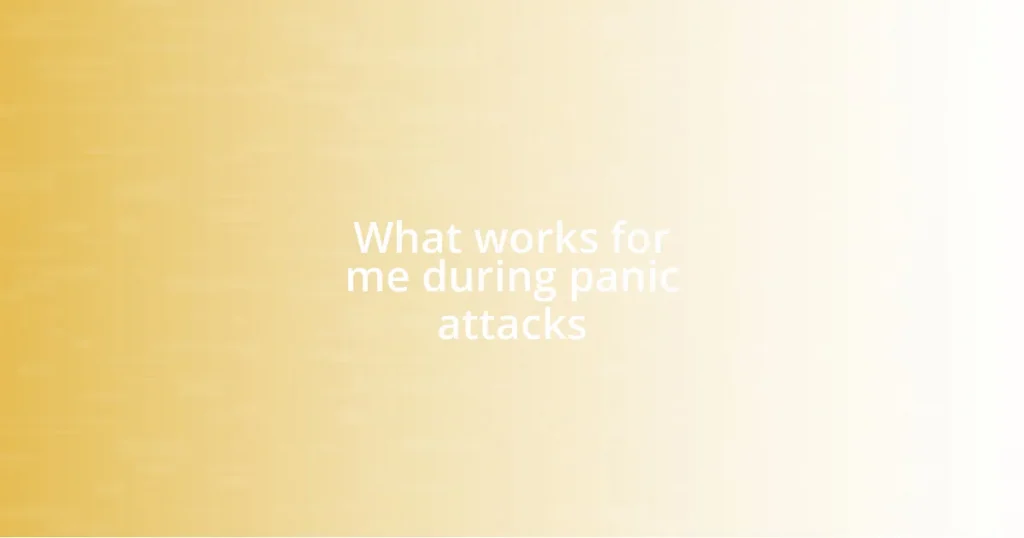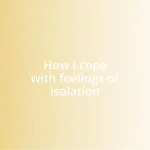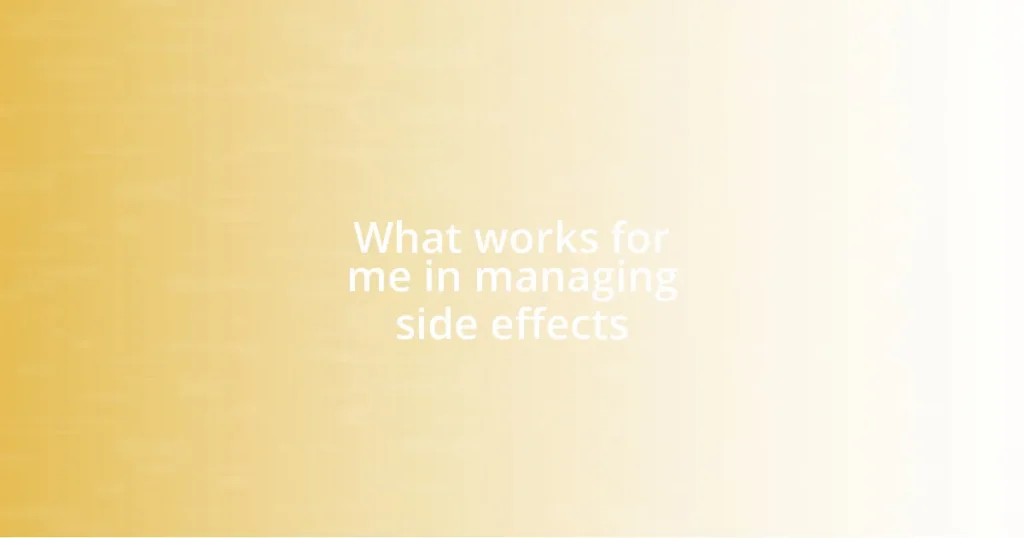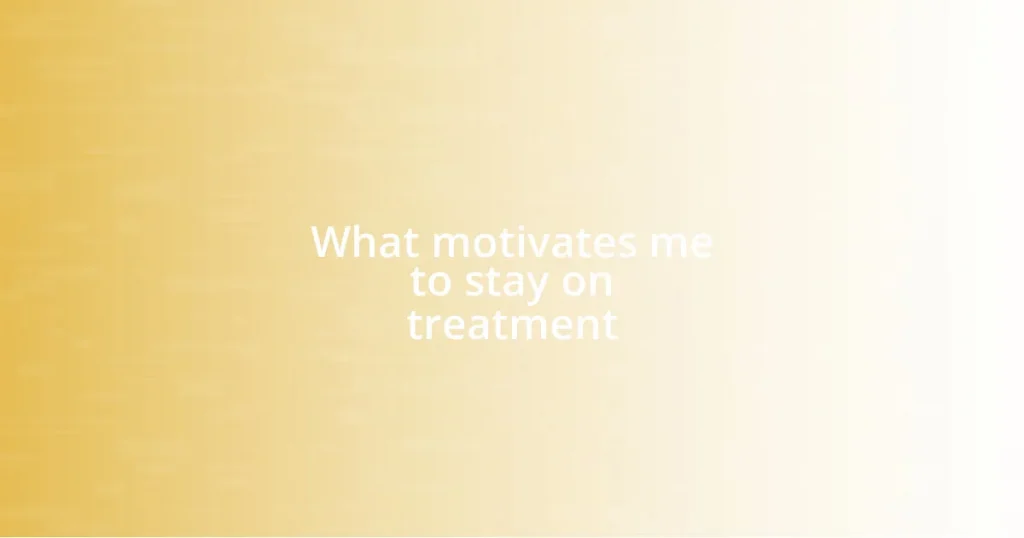Key takeaways:
- Panic attacks involve intense physical and emotional symptoms, making it essential to identify personal triggers for better management.
- Breathing techniques such as 4-7-8, diaphragmatic breathing, and box breathing can significantly alleviate panic symptoms.
- Grounding exercises, including the 5-4-3-2-1 method and mindful observation, help anchor individuals to the present during anxiety episodes.
- Post-attack self-care practices like journaling, seeking support from loved ones, and engaging in soothing activities promote healing and emotional recovery.

Understanding panic attacks
Panic attacks can feel overwhelmingly intense, often striking unexpectedly. I remember the first time I experienced one; my heart raced, and I felt detached from reality. Have you ever been caught off guard by a surge of anxiety that made your surroundings seem distant and surreal?
During a panic attack, it’s not just the mind that races; the body reacts too. Your breath quickens, you might start sweating, and sometimes, a sense of impending doom grips you like a vice. It’s as if your whole being is screaming for something to change, yet you’re frozen in place, battling an invisible enemy. Isn’t it astonishing how profoundly our emotions can affect our physical state?
Understanding the triggers of these episodes can be crucial for managing them. For me, recognizing that stressors like tight deadlines or crowded places could set off an attack has been eye-opening. What about you? Identifying and acknowledging those triggers often leads to a better grasp of our anxieties and can pave the way for finding coping mechanisms that truly work.

Identifying my triggers
I’ve learned that identifying my triggers isn’t just a practical step; it feels like unlocking a hidden door to understanding myself better. For instance, I once noticed that certain music, particularly songs with intense or chaotic sounds, could send my heart racing without warning. It’s strange how a simple melody can evoke memories or emotions that can trigger that familiar panic—really makes you think about the emotional weight of what we consume daily.
Here are some common triggers I’ve discovered:
- Crowded or noisy places, which can feel overwhelming and stifling.
- Time pressures, like looming deadlines that make me feel I’m always racing against the clock.
- Conflicts, whether personal or professional, that create a sense of unresolved tension.
- Specific scents, like the smell of certain chemicals or perfumes that might evoke past experiences.
- Memories of traumatic events that can unexpectedly resurface, reminding me of how fragile emotional stability can be.
By keeping track of these triggers, I’ve started to feel more in control. Acknowledging them gives me the power to prepare and react differently, turning the fear of panic into a learning experience instead.

Breathing techniques that help
Breathing techniques can serve as valuable tools during panic attacks. One method that has worked for me is the 4-7-8 technique. I breathe in for a count of four, hold my breath for seven, and exhale slowly for eight. This rhythm creates a calming effect, almost like a natural sedative for both the body and mind. Have you ever tried to slow down your breath during a moment of chaos? It feels grounding.
Another beneficial approach is diaphragmatic breathing. This involves using your diaphragm rather than your chest to breathe deeply. When I consciously focus on expanding my belly as I inhale, I notice a shift in how my body feels—my heart rate tends to decrease, and with it, the panic slowly subsides. It’s amazing how something so simple can have such profound effects. Have you experienced that moment of clarity when you regain control over your breath?
Lastly, I find that box breathing helps me regain focus when anxiety hits. This technique involves inhaling for four counts, holding for four, exhaling for four, and then holding again for four. The simplicity of counting keeps my mind engaged, steering it away from overwhelming thoughts. I often visualize drawing a square whenever I practice this technique—it’s a sort of mental anchor that guides me back to calmness. Isn’t it fascinating how a structured rhythm can make such a difference during turbulent times?
| Breathing Technique | Description |
|---|---|
| 4-7-8 Breathing | Inhale for 4 seconds, hold for 7, and exhale for 8 seconds to promote relaxation. |
| Diaphragmatic Breathing | Breathe deeply from the diaphragm, allowing the belly to expand, which helps decrease heart rate. |
| Box Breathing | Inhale, hold, exhale, and hold again for 4 counts each, creating a structured rhythm for calm. |

Grounding exercises for relief
Engaging in grounding exercises has been a game-changer for me during moments of panic. One method I often turn to is the 5-4-3-2-1 technique, where I identify five things I can see, four things I can touch, three things I can hear, two things I can smell, and one thing I can taste. This not only helps me anchor myself to the present but also shifts my focus away from my anxiety. Have you ever felt the sheer power of simply being aware of your surroundings?
Another exercise that I find particularly helpful involves holding onto a physical object, like a small stone or a stress ball. I focus on the texture, the temperature, and how it feels in my hand. This tactile experience often grounds me and brings me back from that whirlwind of panic. I remember once, during a particularly overwhelming moment, the rough edges of my stone reminded me that I’m still in control, regardless of what my mind is trying to tell me. Isn’t it comforting to have a tangible reminder of the present?
Lastly, I enjoy engaging my senses through mindful observation. I’ll take a moment to truly savor my environment, perhaps by listening closely to the sound of the wind or catching glimpses of colors around me. One time, as I stood outside, I watched the vibrant sway of leaves in the breeze. That simple act pulled me back to reality, restoring my sense of safety. Have you found that these small moments of mindfulness can shift your perspective during overwhelming times?

Coping strategies during an attack
Finding effective coping strategies during a panic attack can transform the experience from overwhelming to manageable. One technique I often lean on is the “5-4-3-2-1” grounding exercise. It’s simple, yet profound. The last time I did this, I noticed five quirky details about the coffee shop around me—the way the barista’s apron crinkled and the gentle hum of conversations swirled together. It’s like suddenly realizing that life is happening all around, pulling me back from the brink. Have you tried tuning into your environment in this way? It really makes a difference.
Another strategy that resonates deeply with me involves physical touch. When panic strikes, I find comfort in holding something familiar, like my favorite woven blanket. The soft fabric grounds me, reminding me that there’s something solid and real around me. I recall a particularly anxious afternoon where I clutched that blanket, focusing on its warmth and softness. It was as if I could almost feel the tension unraveling, stitch by stitch. Isn’t it incredible how a simple object can provide such emotional solace amidst chaos?
Lastly, during the peak of panic, I often turn to visualization techniques. I close my eyes and imagine a serene place—like the beach at sunset with waves softly crashing. I can almost feel the sand between my toes and the salty breeze on my face. This vivid imagery helps transport me mentally, allowing my focus to shift away from my anxiety. Have you ever allowed your mind to wander to a safe haven when everything feels out of control? It’s a powerful tool to cultivate a sense of peace during turbulent moments, isn’t it?

Post-attack self-care practices
After a panic attack, self-care becomes crucial in restoring balance. One practice I find essential is journaling my thoughts and feelings. It’s like unloading a heavy backpack filled with worries that just doesn’t belong with me anymore. I remember a night when I poured my heart into my notebook after an episode; the release felt like a breath of fresh air. Have you ever experienced that cathartic relief that comes from putting pen to paper?
Another self-care strategy I embrace is seeking connection with loved ones. Sometimes, a simple phone call to a friend or family member can be incredibly grounding after a distressing episode. I recall a time when I reached out to my sister after a particularly tough day. Her voice felt like a comforting hug, reminding me that I was not alone in my struggles. Have you noticed how just talking about what happened can create a sense of community and support?
I also make it a point to indulge in soothing activities after an attack. Whether it’s taking a warm bath while listening to calming music or enjoying a cup of herbal tea, these moments of self-care help me reclaim my sense of calm. I often light a candle and focus on its flickering flame, which serves as a gentle reminder that tranquility can be found even in the chaos. Don’t you find that nurturing yourself afterward creates a pathway to healing?

Resources for further support
When it comes to seeking further support during or after panic attacks, I’ve found that online communities can be incredibly valuable. Engaging with individuals who understand what I’m going through can feel like a warm embrace on a cold day. I often browse forums dedicated to mental health where sharing personal experiences helps me see that I’m not alone—have you ever experienced that sense of belonging when connecting with others who truly get it?
Professional resources like therapists and support groups are also essential. I had my first session with a therapist during a particularly challenging period, and it was enlightening. The insights she offered not only provided me with coping strategies but also helped me understand the root of my anxiety. Finding the right support might take time, but have you thought about how beneficial a conversation with a trained professional could be on your journey towards healing?
Lastly, mobile apps designed for mental well-being can be really handy. I remember downloading a mindfulness app that guided me through breathing exercises during moments of panic. Following along felt like having a coach in my pocket, reminding me to center myself amidst the storm. Have you tried using technology to bolster your mental health? It’s fascinating how these tools can assist us in finding our footing when we feel like we’re losing control.















